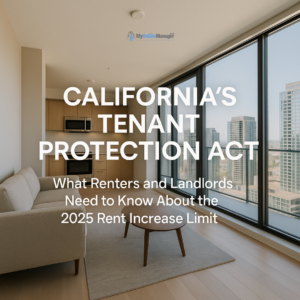California continues to tackle its housing affordability crisis through one of the nation’s strongest rent stabilization measures the Tenant Protection Act of 2019 (AB 1482). As the state experiences rising costs and tightening rental supply, this law helps protect millions of renters from sudden or excessive rent hikes while giving landlords clearer guidelines for compliance.
For 2025, the maximum rent increase allowed under the Act remains capped at 5% plus the regional Consumer Price Index (CPI) or 10%, whichever is lower. This calculation prevents dramatic price spikes that often result from inflation or local housing shortages.
How the Rent Cap Works
Each year, the California Department of Consumer Affairs determines the CPI rates for various regions. Property owners must use the rate that applies to their property’s location when calculating any rent increase.
Example:
If the CPI in Los Angeles County is 3%, the maximum allowable rent increase would be 5% + 3% = 8%.
However, if inflation rises and CPI hits 7%, landlords are still limited to 10% total.
This cap applies to any 12-month period meaning landlords cannot exceed the limit by splitting increases across the year.
Who Is Covered Under AB 1482
The law applies broadly to most multi-unit residential properties in California, but there are some notable exemptions:
-
Single-family homes and condos if owned by an individual (not a corporation or REIT) and if the landlord gives written notice of exemption to the tenant.
-
Newer properties those built within the last 15 years are exempt.
-
Government-subsidized or deed-restricted affordable housing already regulated under separate housing laws.
-
Short-term rentals such as vacation homes or Airbnbs, not typically used for long-term tenancy.
Tenants should always verify whether their unit qualifies under AB 1482, while landlords must include disclosure notices on leases where exemptions apply.
Why This Law Matters in 2025
With the cost of living in California still among the highest in the nation, AB 1482 plays a crucial role in balancing tenant protection and property investment stability.
For renters, it offers:
-
Predictability in housing costs
-
Protection from displacement due to unreasonable hikes
-
Legal recourse if rent increases exceed the cap
For landlords and property managers, it provides:
-
A clear statewide standard for rent increases
-
Fewer disputes caused by confusion over local rent control rules
-
Long-term stability and planning for property income
Common Misunderstandings
-
“The cap applies to all properties.”
Not true – newly built units, single-family homes (with proper notice), and certain exempt buildings are not covered. -
“I can raise rent twice a year as long as I stay under 10%.”
Wrong – the cap applies over a rolling 12-month period, so multiple small increases can still violate the law. -
“Local laws don’t matter anymore.”
False – local rent control ordinances (like in Los Angeles, San Francisco, or Oakland) remain in addition to AB 1482. Landlords must follow the stricter of the two.
Looking Ahead
The Tenant Protection Act remains in effect until January 1, 2030, unless extended or amended. As inflation and housing challenges evolve, lawmakers may revisit the CPI formula or expand tenant protections in coming years.
For now, landlords should:
-
Confirm property coverage
-
Review regional CPI data annually
-
Provide written notice before implementing any rent changes
-
Maintain transparency with tenants
Final Thoughts
California’s rent cap doesn’t eliminate rising costs, but it sets reasonable boundaries in a volatile housing market. For renters, it means peace of mind. For property owners, it promotes sustainable management practices.
As both sides navigate new realities in 2025, awareness and compliance with the Tenant Protection Act are key to maintaining fair, stable housing across the state.
Source: MSN – “California’s Tenant Protection Act: Know the Rent Increase Limit This Year”

